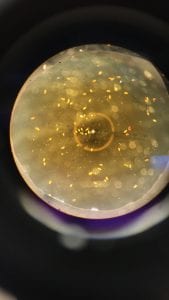Lab 6: Experimental Design and Preparation-09/27/18
09/27/18
Trent McMillan
Lab 6: Experimental Design and Preparation
Objective:
The objectives of this lab were to: create “twine juice”- a polypropylene solution that we will use for our upcoming experiments in researching the effect of microplastics on Tetrahymena, determine ciliate concentration using a shortcut dilution method, and to develop an understanding of and carry out a specific Behavioral Assay-which lets us visually interpret how cells are behaving.
Procedure:
PP “Twine Juice” Production-
- Weigh out 0.5 g of polypropylene twine using an aluminum foil tray, zero out the tray and weigh the twine on the scale.
- Cut the twine into as small of pieces as possible, and put the pieces into a sterile jar.
- Add 50 ml of sterile PPT media using a graduated cylinder.
- Boil and stir/vortex for entire lab.
- Autoclave “twine juice” and store for next week.
Serial Dilutions and Cell Counts-
- Using a micropipettor, transfer 20 μl of Tetrahymena stock solution to a petri dish and add 5 μl of iodine.
- Observe under a compound microscope using the 4x magnification lens.
- Record the number of tetrahymena in the in the sample.
- Repeat steps 1-3 two more times and then calculate the average cells/ml.
Direction Change Assay-
- Using a micropipettor, transfer 18 μl of media to a concave or flat slide, then add 2 μl of the tetrahymena stock solution and mix with the micropipettor to create a 1:10 dilution.
- Using the black light-covering plate for the bottom light, place the slide on the black plate and observe the dilution through a dissecting microscope.
- Watch a specific ciliate for 10 seconds and keep track of how many times it changes direction during the time.
- Repeat step 3 ten times, examining a separate ciliate each time around.
- Calculate the average amount of direction changes.
Data:
Serial Dilution Cell Counts:
| Drop # | # of Cells in the Drop cells/20μl | Concentration cells/ml |
| 1 | 55 | 2750 |
| 2 | 62 | 3100 |
| 3 | 67 | 3350 |
| Average: | 61.3 | 3065 |
Direction Change Assay-
| Cell |
# of Direction Changes /10 seconds |
| 1 | 5 |
| 2 | 4 |
| 3 | 2 |
| 4 | 4 |
| 5 | 3 |
| 6 | 4 |
| 7 | 4 |
| 8 | 4 |
| 9 | 2 |
| 10 | 3 |
| Average: | 3.5 changes/sec |
Storage:
PP Microplastic Production-
We gave the “twine juice” to our instructor after producing it. The instructors will autoclave the twine juice and store it properly for our next lab.
Serial Dilution and Cell Counts-
The solutions of which we examined were left in the tube racks for the next class to use, we turned off and put up all of the microscopes and micropipettors properly. We then took all of the slides and petri dishes that were used and cleaned them with bleach water and left them to dry.
Direction Assay:
The storage for this procedure was the same as the Serial Dilution and Cell Counts procedure.
Conclusion:
In conclusion, creating the “twine juice” was an important step in kicking off our research experiments. The twine juice will allow us to properly experiment the effect of microplastics on Tetrahymena since it is a controlled substance that everyone in the class will be using, this will also enhance the results of different experiments throughout the class as we will all be using the same microplastic. The serial dilutions and cell counts will be very helpful in coming labs as we experiment on Tetrahymena, this procedure enhanced our knowledge toward conducting experiments of this sort and made us more familiar with the procedure. The directional assay was also a great way to practice and get familiar with procedures we will be using while conducting our research experiments. Knowing how to examine the behaviors of our cells before and after they are effected by microplastics will play a huge role in our experiments success.
Future steps:
In future labs, we will use all of these procedures to benefit our upcoming experiment. The twine juice will used to introduce our Tetrahymena to microplastics and the other procedures will enhance our results. I am looking forward to putting these new-found skills to use as we conduct our research, knowing that they will benefit both my knowledge of scientific research as well as our experiment.

